Case Study of a MEMS Snap-Through Actuator: Modeling and Fabrication Considerations
Abstract
:1. Introduction
2. Design

3. Characterization
3.1. Refined Analytical Model
3.2. Application in Fabricated Structures
3.3. Anti-Symmetric Mode
- If α < β, branch 1 and branch 4 have extra compressive stress while branch 2 and branch 3 have extra tensile stress;
- If α = β, no extra stress is applied;
- If α > β, branch 1 and branch 4 have extra tensile stress while branch 2 and branch 3 have extra compressive stress.
4. Discussion
- 1.
- if is negative, the corresponding branch is more curved;
- 2.
- if is positive, the corresponding branch is less curved, or can even be flattened when = 0.
5. Conclusions
Author Contributions
Funding
Institutional Review Board Statement
Acknowledgments
Conflicts of Interest
References
- Agrawal, V.; Mitra, B. Study and Analysis of Hollow Bistable MEMS Switch. In Proceedings of the 2018 IEEE Sensors, New Delhi, India, 28–31 October 2018; pp. 1–4. [Google Scholar] [CrossRef]
- Xu, Q. Design, Fabrication, and Testing of an MEMS Microgripper with Dual-Axis Force Sensor. IEEE Sens. J. 2015, 15, 6017–6026. [Google Scholar] [CrossRef]
- Hafiz, M.A.A.; Kosuru, L.; Ramini, A.; Chappanda, K.N.; Younis, M.I. In-Plane MEMS Shallow Arch Beam for Mechanical Memory. Micromachines 2016, 7, 191. [Google Scholar] [CrossRef] [PubMed] [Green Version]
- Hoffmann, M.; Voges, E. Bulk silicon micromachining for MEMS in optical communication systems. J. Micromech. Microeng. 2002, 12, 4. [Google Scholar] [CrossRef]
- Nguyen, S.D.; Halvorsen, E.; Paprotny, I. Bistable springs for wideband microelectromechanical energy harvesters. Appl. Phys. Lett. 2013, 102, 023904. [Google Scholar] [CrossRef] [Green Version]
- Murotani, K.; Suzuki, Y. MEMS electret energy harvester with embedded bistable electrostatic spring for broadband response. J. Micromech. Microeng. 2018, 28, 10. [Google Scholar] [CrossRef]
- Xu, R.; Akay, H.; Kim, S.G. Buckled MEMS Beams for Energy Harvesting from Low Frequency Vibrations. Research 2019, 8, 1087946. [Google Scholar] [CrossRef] [Green Version]
- Chen, Q.; Haddab, Y.; Lutz, P. Microfabricated bistable module for digital microrobotics. J. Micro-Nano Mechatron. 2011, 6, 1–12. [Google Scholar] [CrossRef] [Green Version]
- Timoshenko, S.P.; Gere, J.M. Theory of Elastic Stability, 2nd ed.; McGraw-Hill: New York, NY, USA, 1961. [Google Scholar]
- Crisfield, M.A. A fast incremental-iterative solution procedure that handles snap-through. Comput. Struct. 1981, 13, 55–62. [Google Scholar] [CrossRef]
- Vangbo, M. An analytical analysis of a compressed bistable buckled beam. Sens. Actuators A Phys. 1998, 69, 212–216. [Google Scholar] [CrossRef]
- Qiu, J.; Lang, J.H.; Slocum, A.H. A curved-beam bistable mechanism. JMEMS 2004, 13, 137–146. [Google Scholar] [CrossRef]
- Shi, Z.; Bouville, D.; Martincic, E.; Moulin, J.; Lefeuvre, E.; Lamarque, F. Design, fabrication and characterization of a buckled beam actuator for micro-displacement applications. In Proceedings of the 2019 Symposium on Design, Test, Integration & Packaging of MEMS and MOEMS (DTIP), Paris, France, 12–15 May 2019. [Google Scholar] [CrossRef]
- Chen, G.; Ma, F. Kinetostatic modeling of fully compliant bistable mechanisms using Timoshenko beam constraint model. J. Mech. Des. 2015, 137, 022301. [Google Scholar] [CrossRef]
- Ma, F.; Chen, G. Bi-BCM: A closed-form solution for fixed-guided beams in compliant mechanisms. J. Mech. Robot. 2017, 9, 014501. [Google Scholar] [CrossRef]
- Bruch, D.; Hau, S.; Loew, P.; Rizzello, G.; Seelecke, S. Fast model-based design of large stroke dielectric elastomer membrane actuators biased with pre-stressed buckled beams. In Electroactive Polymer Actuators and Devices (EAPAD) XX; SPIE: Denver, CO, USA, 2018; Volume 10594, p. 105940H. [Google Scholar] [CrossRef]
- Hussein, H.; Bouhadda, I.; Mohand-Ousaid, A.; Bourbon, G.; Le Moal, P.; Haddab, Y.; Lutz, P. Design and fabrication of novel discrete actuators for microrobotic tasks. Sens. Actuators A Phys. 2018, 271, 373–382. [Google Scholar] [CrossRef]
- Hussein, H.; Le Moal, P.; Younes, R.; Bourbon, G.; Haddab, Y.; Lutz, P. On the design of a preshaped curved beam bistable mechanism. Mech. Mach. Theory 2019, 131, 204–217. [Google Scholar] [CrossRef]
- Palathingal, S.; Ananthasuresh, G.K. Analysis and Design of Fixed–Fixed Bistable Arch-Profiles Using a Bilateral Relationship. J. Mech. Robot. 2019, 11, 031002. [Google Scholar] [CrossRef]
- Chen, G.; Ma, F.; Hao, G.; Zhu, W. Modeling large deflections of initially curved beams in compliant mechanisms using chained beam constraint model. J. Mech. Robot. 2019, 11, 011002. [Google Scholar] [CrossRef]
- Hussein, H.; Younis, M.I. Analytical study of the snap-through and bistability of beams with arbitrarily initial shape. J. Mech. Robot. 2020, 12, 041001. [Google Scholar] [CrossRef]
- Thachil, G.; Nair, D.R.; DasGupta, A. Design and Fabrication of Reliable Power Efficient Bistable MEMS Switch Using Single Mask Process. JMEMS 2020, 29, 1225–1233. [Google Scholar] [CrossRef]
- Huang, S.W.; Lin, F.C.; Yang, Y.J. A novel single-actuator bistable microdevice with a moment-driven mechanism. Sens. Actuators A Phys. 2020, 310, 111934. [Google Scholar] [CrossRef]
- Zaidi, S.; Lamarque, F.; Prelle, C.; Hoxhold, B.; Doré, E.; Pouille, P.; Büttgenbach, S. Bistable curved-beam actuated by optically controlled Shape Memory Alloy. In Proceedings of the 2010 IEEE/ASME International Conference on Advanced Intelligent Mechatronics, Montreal, QC, Canada, 6–9 July 2010; pp. 1140–1145. [Google Scholar] [CrossRef]
- Jeon, J.-H.; Cheng, T.-H.; Oh, I.-K. Snap-through dynamics of buckled IPMC actuator. Sens. Actuators A Phys. 2010, 158, 300–305. [Google Scholar] [CrossRef]
- Liu, X.; Lamarque, F.; Doré, E.; Pouille, P. Multistable wireless micro-actuator based on antagonistic pre-shaped double beams. Smart Mater. Struct. 2015, 24, 075028. [Google Scholar] [CrossRef]
- Park, S.; Hah, D. Pre-shaped buckled-beam actuators: Theory and experiments. Sens. Actuators A Phys. 2008, 14, 186–192. [Google Scholar] [CrossRef]
- Vangbo, M.; Backlund, Y. A lateral symmetrically bistable buckled beam. J. Micromech. Microeng. 1998, 8, 29–32. [Google Scholar] [CrossRef]
- Casals-Terre, J.; Shkel, A. Snap-action bistable micromechanism actuated by nonlinear resonance. In Proceedings of the 2005 IEEE Sensors, Irvine, CA, USA, 30 October–3 November 2005; pp. 893–896. [Google Scholar] [CrossRef]
- Camescasse, B.; Fernandes, A.; Pouget, J. Bistable buckled beam: Elastica modeling and analysis of static actuation. Int. J. Solids Struct. 2013, 50, 2881–2893. [Google Scholar] [CrossRef]
- Vysotskyi, B.; Aubry, D.; Gaucher, P.; Le Roux, X.; Parrain, F.; Lefeuvre, E. Nonlinear electrostatic energy harvester using compensational springs in gravity field. JMM 2018, 28, 074004. [Google Scholar] [CrossRef]
- Vysotskyi, B.; Parrain, F.; Aubry, D.; Gaucher, P.; Le Roux, X.; Lefeuvre, E. Engineering the structural nonlinearity using multimodal-shaped springs in MEMS. JMEMS 2017, 27, 40–46. [Google Scholar] [CrossRef]
- Ramini, A.; Bellaredj, M.L.F.; Al Hafiz, A.; I Younis, M. Experimental investigation of snap-through motion of in-plane MEMS shallow arches under electrostatic excitation. JMM 2015, 26, 015012. [Google Scholar] [CrossRef]

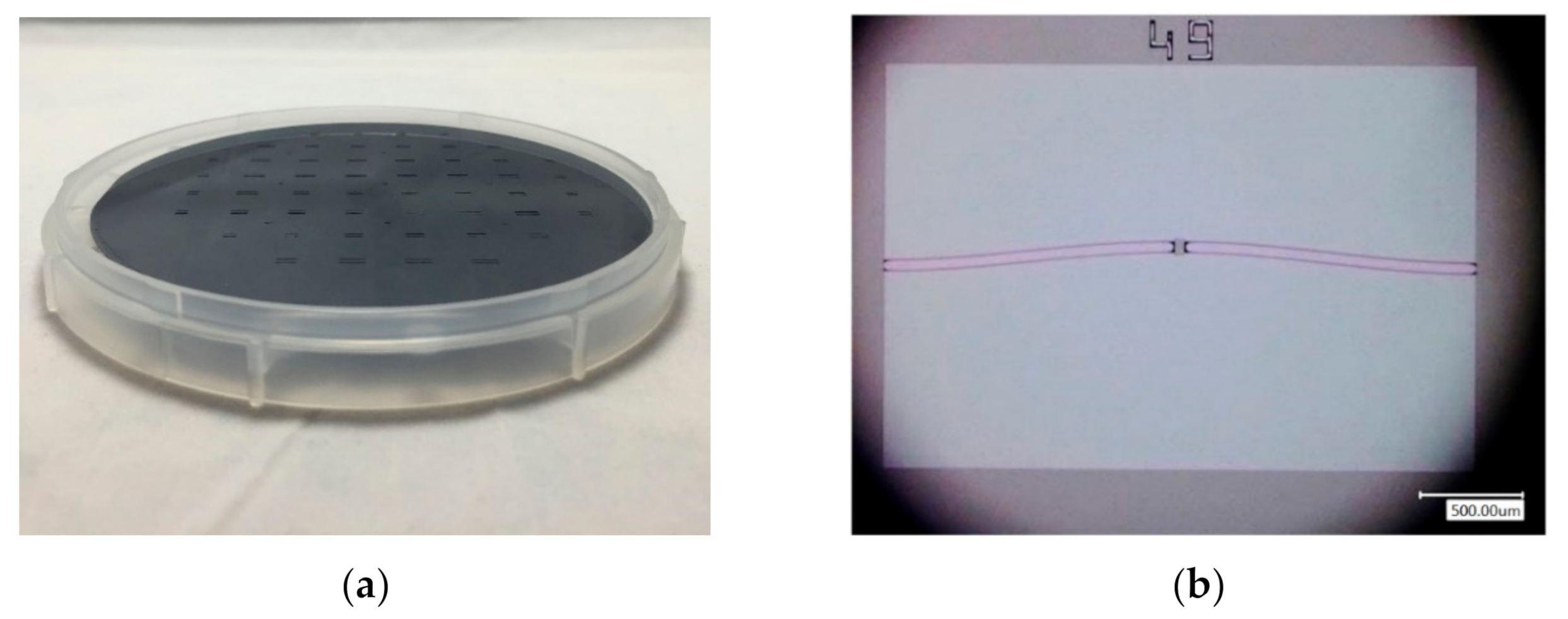

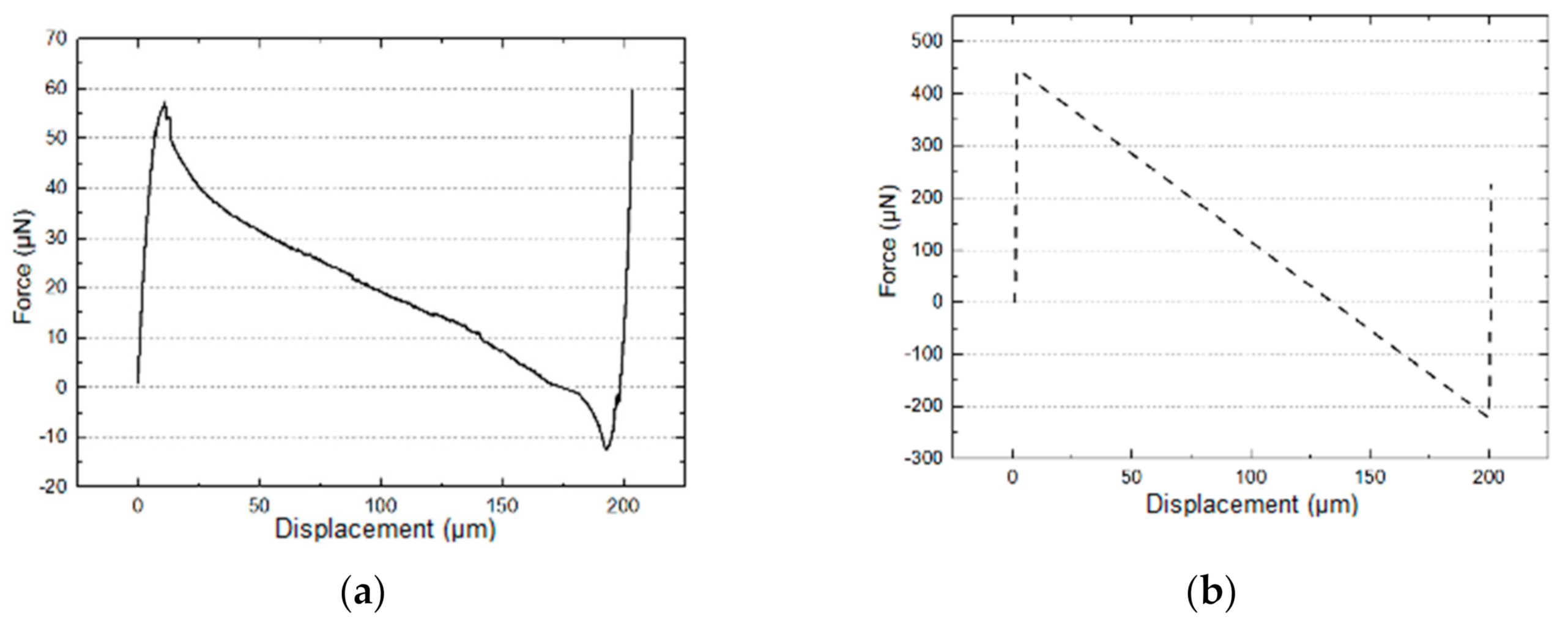

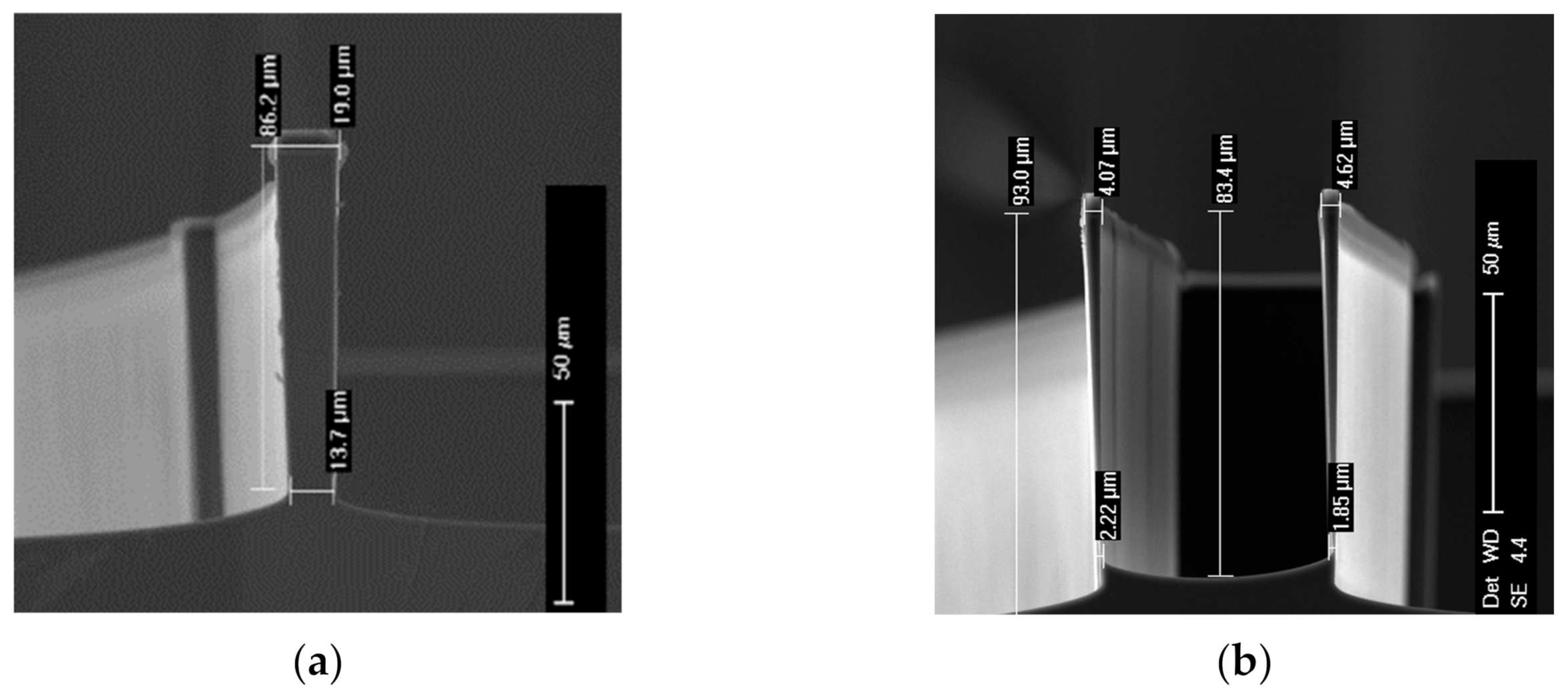


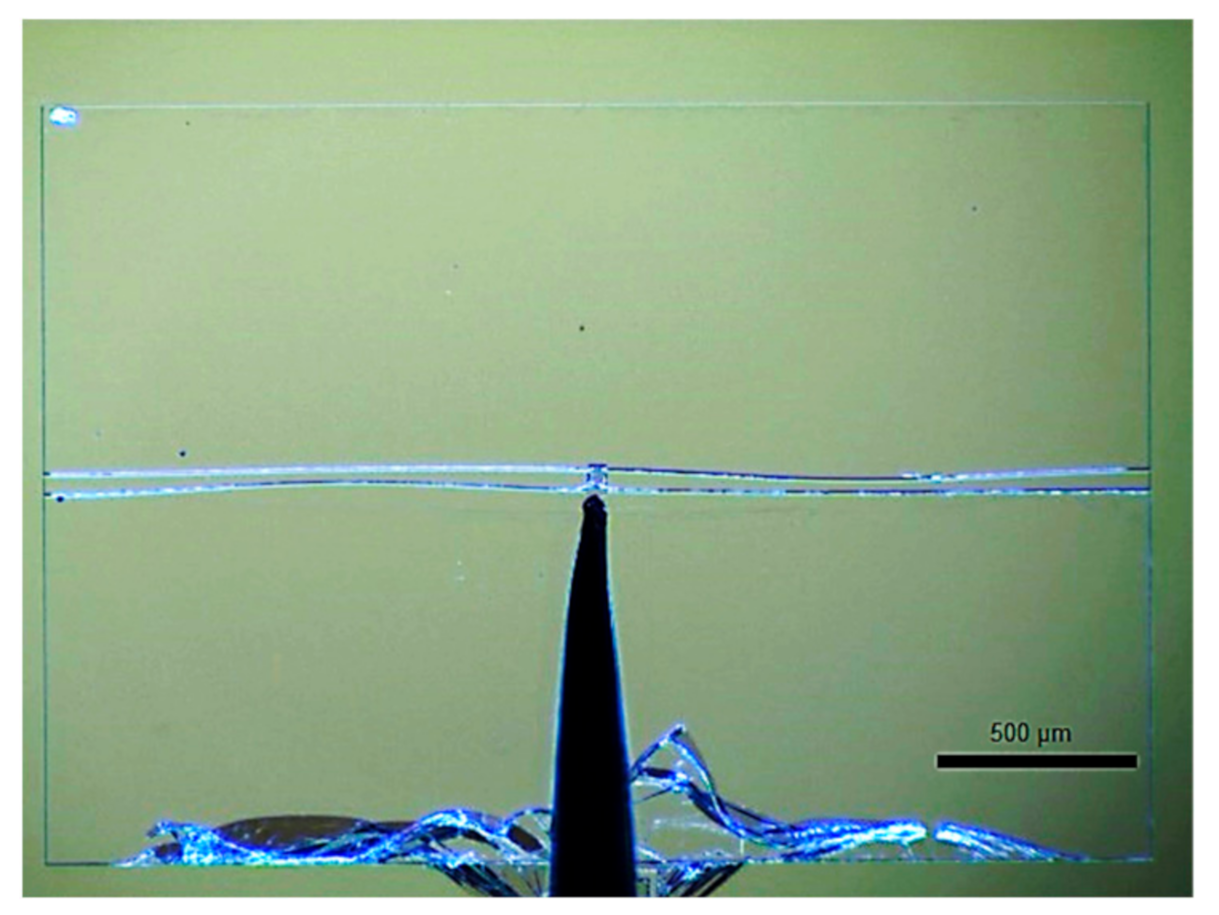

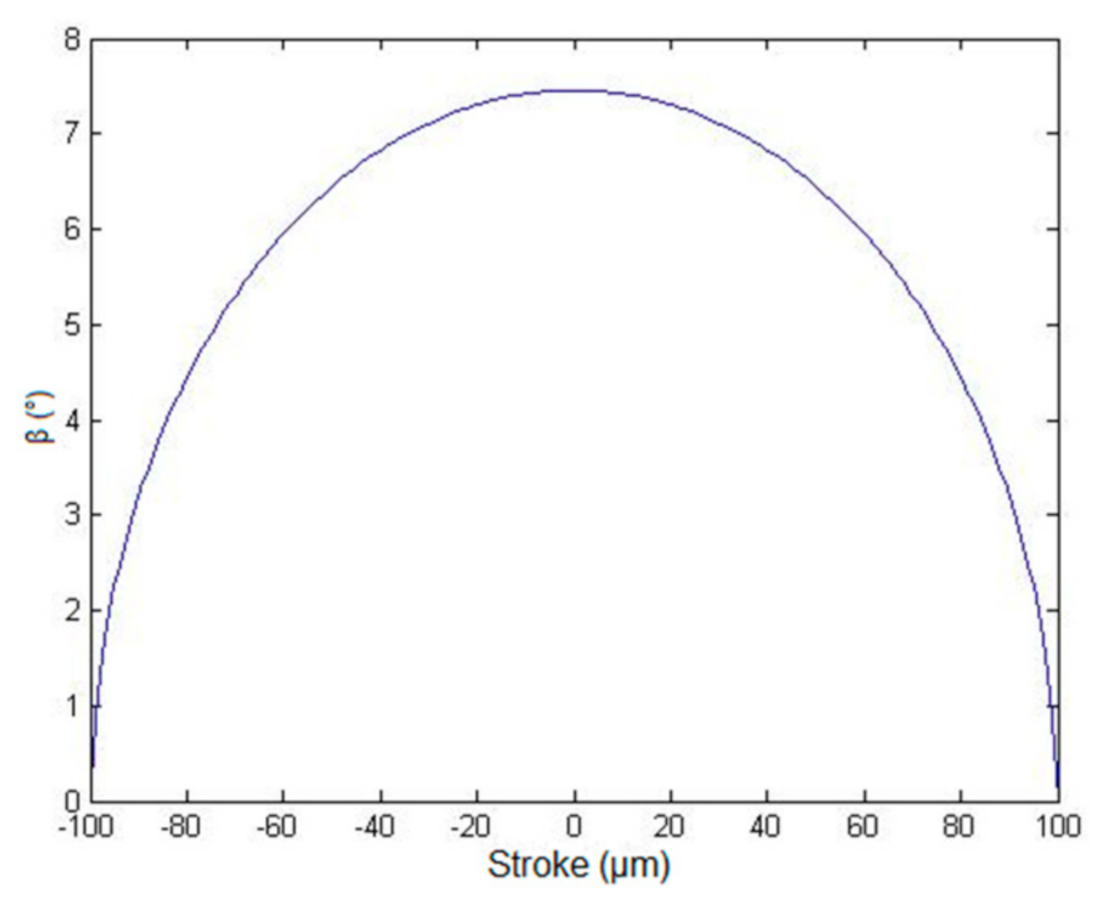
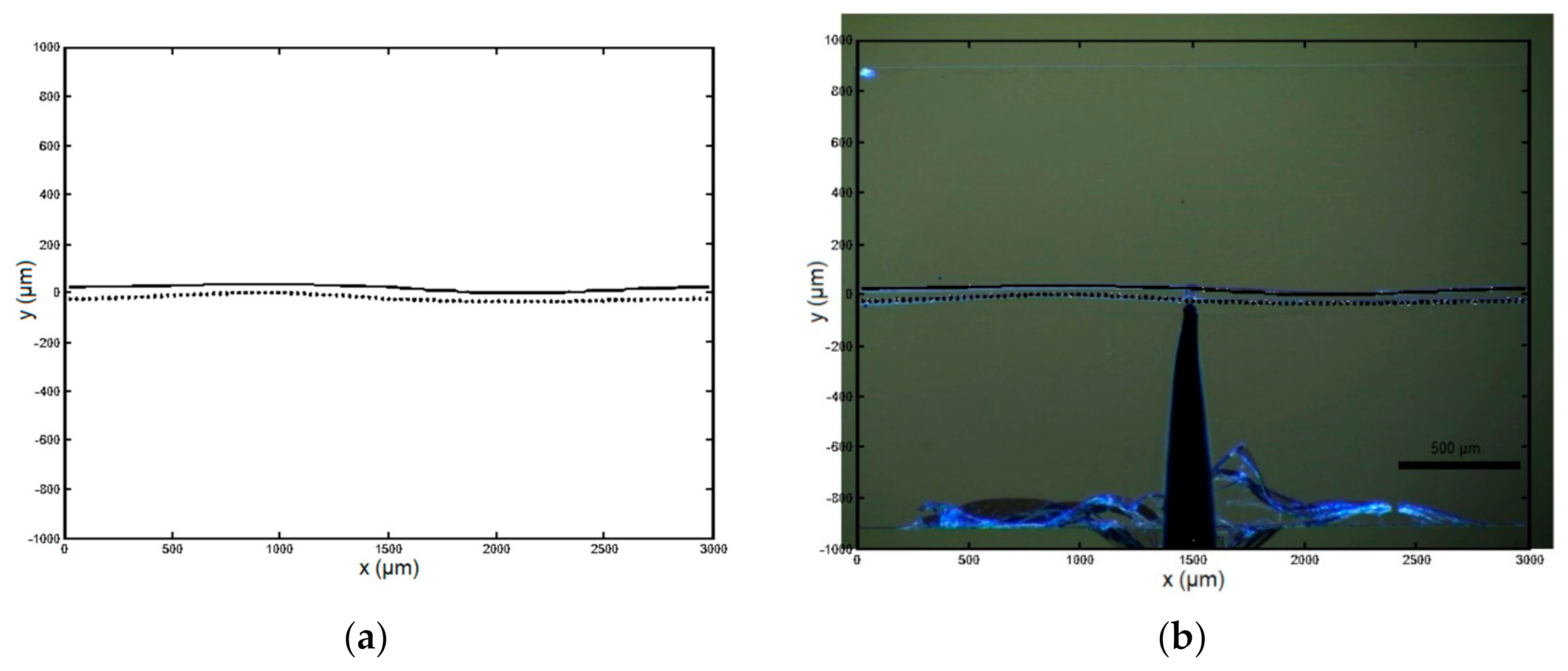
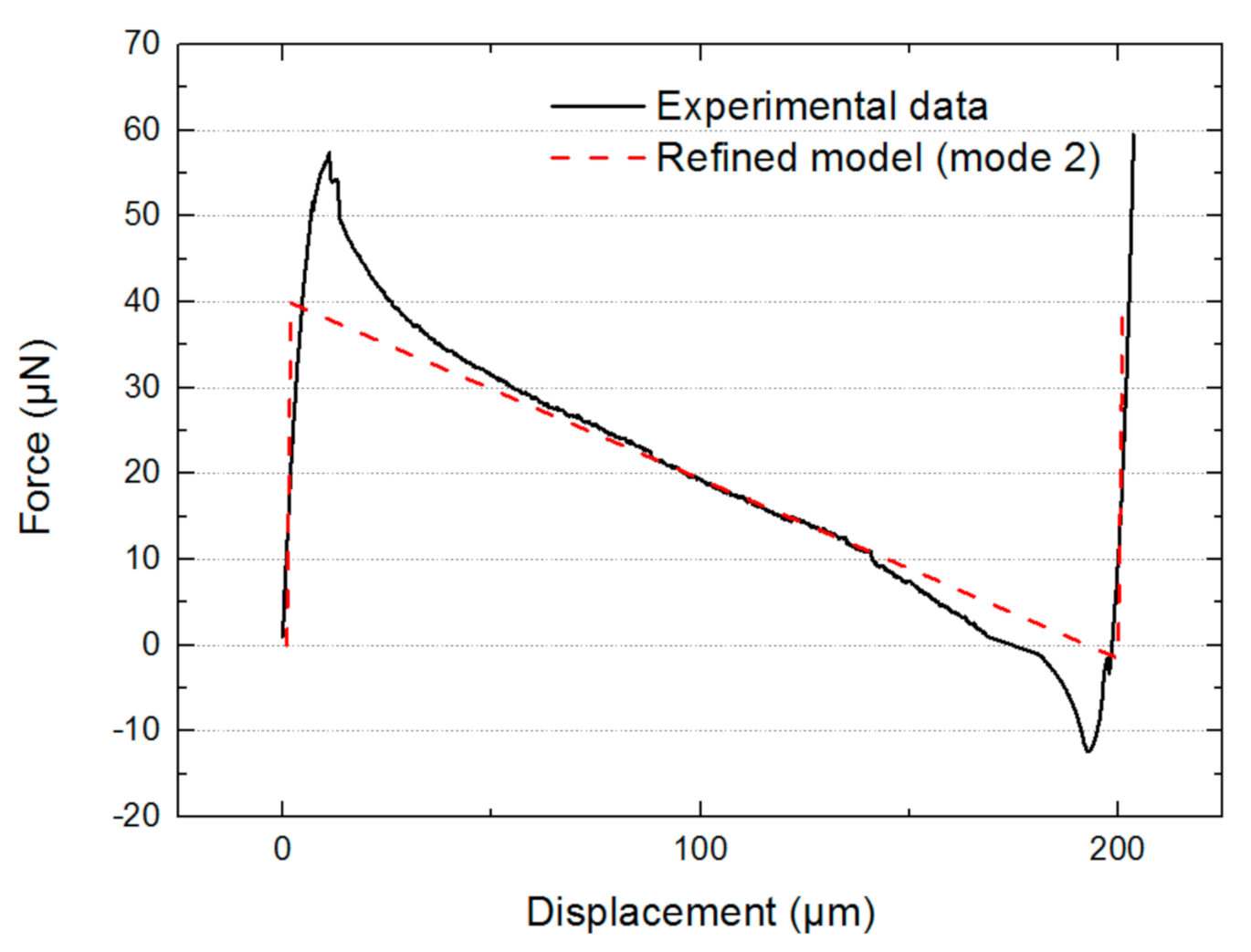
| Notation | Parameter |
|---|---|
| b | Thickness of the beam |
| t | Width of the beam |
| l | Length of the beam |
| h | Apex height of the pre-shaped beam |
| Q | Geometric factor of the beam |
| d | Central deflection of the beam |
| w | Deflected shape of the beam |
| x | Longitudinal coordinates |
| E | Young’s modulus |
| I | Moment of inertia of the beam |
| p | Axial force in the beam |
| s | Total length of the beam |
| f | Actuation force |
| Δ | Normalized central deflection |
| W | Normalized deflected shape |
| X | Normalized longitudinal coordinates |
| N2 | Normalized axial stress |
| S | Normalized total length |
| F | Normalized actuation force |
Publisher’s Note: MDPI stays neutral with regard to jurisdictional claims in published maps and institutional affiliations. |
© 2022 by the authors. Licensee MDPI, Basel, Switzerland. This article is an open access article distributed under the terms and conditions of the Creative Commons Attribution (CC BY) license (https://creativecommons.org/licenses/by/4.0/).
Share and Cite
Shi, Z.; Martincic, E.; Moulin, J.; Lefeuvre, E.; Lamarque, F. Case Study of a MEMS Snap-Through Actuator: Modeling and Fabrication Considerations. Micromachines 2022, 13, 654. https://doi.org/10.3390/mi13050654
Shi Z, Martincic E, Moulin J, Lefeuvre E, Lamarque F. Case Study of a MEMS Snap-Through Actuator: Modeling and Fabrication Considerations. Micromachines. 2022; 13(5):654. https://doi.org/10.3390/mi13050654
Chicago/Turabian StyleShi, Zhichao, Emile Martincic, Johan Moulin, Elie Lefeuvre, and Frédéric Lamarque. 2022. "Case Study of a MEMS Snap-Through Actuator: Modeling and Fabrication Considerations" Micromachines 13, no. 5: 654. https://doi.org/10.3390/mi13050654






